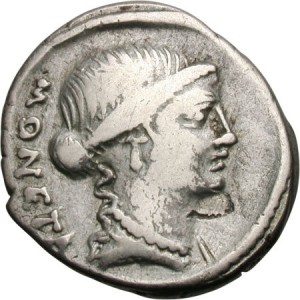By Gerald Tebben
The first money had no substance, but it changed the course of history.
It was born of carnage, but it was all sound and fury. It did not contain so much as an atom of gold or silver, or copper or any other metal. The first money was the excited honking of geese in the night some 2,400 years ago.
About 400 years before the birth of Christ, Germanic tribes pushed Celtic Gauls south from the Danube.
One tribe, the Senones, under the command of a chieftain named Brennus, laid siege to Rome, encamping at the base of the heavily fortified Capitoline Hill.
The temple of Juno, Rome’s moon goddess, stood atop the hill. Sacred geese lived in its sanctuary. These fowl were so revered that the Romans did not eat them during the famine that accompanied Brennus’ seven-month siege.
The geese repaid the Romans by honking in the night as Brennus’ troops scaled the summit, awakening Marcus Manlius, who roused his fellow Romans to repel the attack. The Latin word for “warning” is “moneta.” Over the course of the centuries, the “moneta” of Juno’s sacred geese became the coins and currency we spend today—money.
Roman historian Titus Livius, known as Livy, told the story of the 390 B.C. assault in his “History of Rome”:
“Choosing a night when there was a faint glimmer of light, [the Gauls] sent an unarmed man in advance to try the road; then handing one another their arms where the path was difficult, and supporting each other or dragging each other up as the ground required, they finally reached the summit.” So silent had their movements been that not only were they unnoticed by the sentinels, but they did not even wake the dogs, an animal peculiarly sensitive to nocturnal sounds. But they did not escape the notice of the geese, which were sacred to Juno and had been left untouched in spite of the extremely scanty supply of food. This proved the safety of the garrison, for their clamor and the noise of their wings aroused M. Manlius, the distinguished soldier, who had been consul three years before.
He snatched up his weapons and ran to call the rest to arms, and while the rest hung back he struck with the boss of his shield a Gaul who had got a foothold on the summit and knocked him down.
He fell on those behind and upset them, and Manlius slew others who had laid aside their weapons and were clinging to the rocks with their hands.
By this time others had joined him, and they began to dislodge the enemy with volleys of stones and javelins till the whole body fell helplessly down to the bottom.”
Despite the loss, the Gauls maintained the siege, forcing the Romans to sue for peace. In the end, the Romans agreed to pay 1,000 pounds of gold.
“This humiliation was great enough as it was, but it was aggravated by the despicable meanness of the Gauls, who produced unjust weights, and when the tribune protested, the insolent Gaul threw his sword into the scale, with an exclamation intolerable to Roman ears, ‘Woe to the vanquished!’”
While Manlius was hailed as a hero, a few years later he found himself on the wrong side of an internal political squabble—fittingly over money. He was convicted of treason and thrown to his death from the very hill he had defended.
In recognition of her service to the city, the goddess Juno was given a new title: “Juno Moneta,” or “Juno the Warner.” A new temple was built in her honor in 344, by legend on the site of Marcus Manlius’ home.
During the Roman Republic, perhaps as early as 269 B.C., a mint was operated either in or near the temple.
The goddess was a common reverse type on coins struck there.
The legend “Juno Moneta” is frequently found on her coins. Over the centuries, the goddess’ attribute “moneta” came to be used as the name for “mint” and later “money.”
Gerald Tebben, a longtime numismatist, is editor of the Central States Numismatic Society’s Centinel and a contributing writer to Coin World.
WorthPoint—Discover Your Hidden Wealth

























